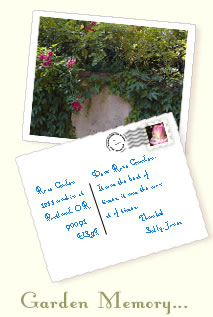
|
    |

Did you know that:
- By about 1200 AD the first five groups of domesticated roses had already begun to evolve in cultivation: Albas, Centifolias, Damasks, Gallicas and Scots Roses.
- The first guide to roses was written around 300 BC by Theophrastus, a pupil of Plato and Aristotle. Pliny the Roman went into more detail 200 years later with the equivalent of the world’s first catalogue, which listed thirteen roses.
- It was in France, from about 1820, that the deliberate and planned hybridizing of new roses from pre-selected plants began, leading to strange new classes like Noisettes, Portlands and Bourbons.
- The Far East was the birthplace of the Modern Garden Rose at the end of the eighteenth century, with the discovery of R. chinensis in China. The revolutionary characteristic of this rose is its ability to flower repeatedly from early summer to late autumn. The crusaders returned to the west with rose plants, which were then cultivated by monks for their medicinal properties. Rose water was claimed to cure all kinds of ailments, such as trembling, constipation, drunkenness, skin and throat infections and insomnia.
- Until the early nineteenth century dried rose petals were believed to have mysterious powers. Napoleon gave his officers bags of rose petals to boil in white wine to cure lead poisoning from bullet wounds.
- A rose language was invented as a means of communication between lovers who were not allowed to express their feelings in the harems of the Middle East. Lady Mary Wortley Montagu, the wife of the British ambassador in Constantinople in the mid-eighteenth century, described in her letters how a red rose bud stands for budding desire, while an open white rose asks "Will you love me?". An open red rose means "I’m full of love and desire", while an open yellow rose asks "Don’t you love me any more?".
- It has been estimated that 150 million rose plants are purchased by gardeners worldwide every year.
- The Wars of the Roses
The Wars of the Roses were fought in Britain in the fifteenth century during the reign of Henry VI. These civil wars raged for thirty years, and both sides used the rose as a symbol. The Red Rose of Lancaster was ultimately victorious; the White Rose of York belonged to the vanquished. Shakespeare wrote about this bloody conflict in his epic three-part tragedy, Henry VI. (The Rose, by Madison Mallone, Andrews and McMeel, a Universal Press Syndicate Company, Kansas City, MO, pgs. 81-82).
- The Peace Rose
During World War II, just before the Nazis stormed the airport in Lyons, France, a Frenchman smuggled a few plants of the new rose he had created onto one of the last planes out. It was cared for by an American until the war’s end. This luminous pale yellow rose with a tinge of pink was named “Peace” and became the symbol for the fall of Berlin and the end of the war. The famous “Peace” rose is now celebrating its fiftieth anniversary. (The Rose, by Madison Mallone, Andrews and McMeel, a Universal Press Syndicate Company, Kansas City, MO, pgs. 82-83).
- Cave Paintings
Perhaps the oldest painting in the world depicts a five-petaled pink rose. It resides in a cave on the island of Crete and dates to about 1450 B.C. (The Rose, by Madison Mallone, Andrews and McMeel, a Universal Press Syndicate Company, Kansas City, MO, pg. 99)
- Largest
The world’s largest rose-bush is located in Tombstone, Arizona. It is almost two hundred years old and is adorned with more than two hundred thousand white blooms when in full bloom. Its trunk is nearly six feet in diameter, and its branches form a canopy large enough to shelter a crowd of 150 people. (The Rose, by Madison Mallone, Andrews and McMeel, a Universal Press Syndicate Company, Kansas City, MO, pgs. 115-116).
- Oldest
The oldest living rose bush, which is now the size of tree, grows against a cathedral in Hildesheim, Germany. Documentation proves it has been there since A.D. 815. During World War II, the bush caught fire from Allied bombs dropped nearby, but the root system was undamaged and the bush still flourishes today. (The Rose, by Madison Mallone, Andrews and McMeel, a Universal Press Syndicate Company, Kansas City, MO, pgs. 35-36).
- Roses and Romance
Cleopatra (69 - 30 B.C.) celebrated the rose as an aphrodisiac; when she held a banquet in honor of her lover, Mark Anthony, in 42 B.C., the floor was carpeted with two feet of roses petals. Her bed was also covered with fresh roses daily, as were the beds of newlyweds in Roman times and rose wreaths were often hung by lovers on the doors of their beloved’s boudoirs. (The Rose, by Madison Mallone, Andrews and McMeel, a Universal Press Syndicate Company, Kansas City, MO, pgs. 51-52).
- First Greenhouses
Determined to find a way to get roses to bloom all year round, the Romans piped hot water into special growing rooms, creating the worlds first greenhouses. (The Rose, by Madison Mallone, Andrews and McMeel, a Universal Press Syndicate Company, Kansas City, MO, pgs. 56-57).
Back to Top >>
|
|
|


"Roses just cannot grow out here on our farm, it's too hot/cold/windy. But you have a beautiful bird bath with a red rose glass mosaic..."
-- L Blanchfield
Churdan, IA United States
Submit a Garden Memory >
Read more memories >
|